Pallet Changing Machine: What’s the Best Way to Change PPE Pallets?
Handling large volumes of Personal Protective Equipment (PPE) comes with unique challenges. You need to move products quickly and hygienically, but the process of changing pallets from in-house to shipping, or wood to plastic, is often a major bottleneck. Manual handling is slow, poses a risk of injury to your team, and can introduce contamination, compromising the integrity of the very products meant to protect others. This manual process doesn't just slow down your operation; it directly impacts your bottom line through inefficiency, potential product damage, and safety liabilities. What if there was a way to solve all these problems with a single, strategic investment?
The best way to change PPE pallets is by using an automated pallet changing machine, often called a pallet inverter or pallet exchanger. This equipment securely clamps the entire load, rotates or pushes it, and allows for the quick, safe, and hygienic swap of pallets without any manual lifting. For PPE, a stainless steel, wash-down compatible model is the ideal choice to ensure compliance and product safety.
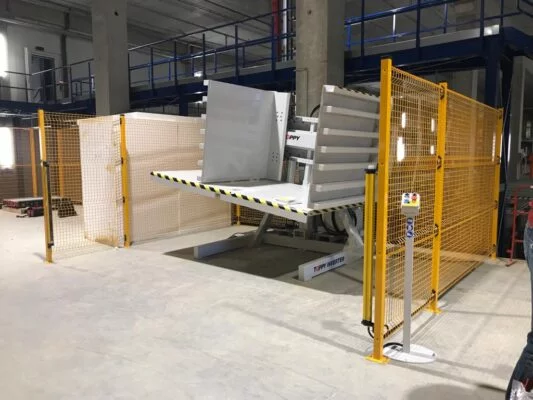
I’ve spent my entire career in the packaging machinery world, first as an engineer and now as a factory owner. I’ve seen firsthand how a seemingly small operational challenge can create major ripples across a business. Pallet handling is one of those areas. It’s not just about moving boxes; it’s about safety, efficiency, and protecting the value of your goods. In this article, I want to share my knowledge to help you understand these machines better. We will explore what they are, how to choose the right one for your PPE operations, and what features truly matter for a successful implementation.
What is a pallet changing machine and why is it crucial for PPE handling?
Your warehouse is busy. Palletized loads of PPE need to be moved from production to storage, then prepared for shipping. But the pallets used inside your facility might not be suitable for export. Or maybe you need to switch from a standard wooden pallet to a hygienic plastic one for cleanroom entry. This need to switch pallets is a constant. The problem is that doing it by hand is a terrible job. It involves unstacking and restacking heavy boxes, which is physically demanding, incredibly slow, and a prime opportunity for products to be dropped and damaged. For PPE, every manual touchpoint also increases the risk of contamination, which is simply not acceptable.
A pallet changing machine is the solution to this operational headache. It’s a piece of equipment designed to do one thing perfectly: transfer a fully loaded pallet of goods to a new pallet. It accomplishes this without requiring your team to touch the individual boxes. This automation is not just a luxury; for handling sensitive goods like PPE, it’s a necessity. It protects your employees from strain, your products from damage, and your company from the risks of non-compliance with hygiene standards. Think of it as an investment in a safer, faster, and cleaner workflow.
A pallet changing machine is a piece of industrial equipment that automates the transfer of a full product load from one pallet to another. It is crucial for handling PPE because it eliminates manual restacking, which ensures product hygiene, prevents contamination, enhances worker safety, and dramatically increases the speed of logistics operations.
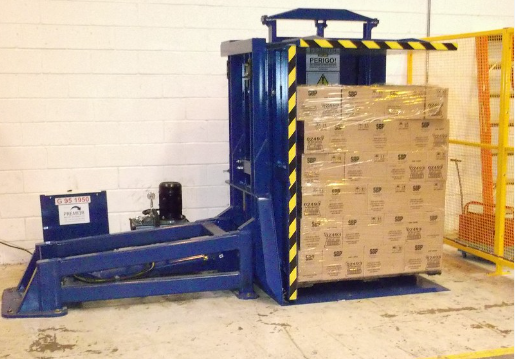
Deeper Dive: The Mechanics and Strategic Importance
Let’s get into the details of how these machines operate and why they are so valuable, especially for a high-stakes industry like PPE manufacturing or distribution. Understanding the 'how' helps you appreciate the 'why'.
How Pallet Changers Work
There are generally two main types of pallet changing machines, each suited for different applications:
-
Pallet Inverters: This is the most common type. A forklift places the entire palletized load into the machine. The machine then uses pressure-controlled clamping plates to secure the load from the top and bottom. The entire unit then rotates, typically 180 degrees, so the original pallet is on top. The operator can then easily remove the old pallet and place a new one. The machine rotates back, and the load now sits on the new pallet. This method is excellent for stable, boxed goods like cases of gloves, masks, or gowns.
-
Pallet Exchangers (Push-Pull Type): This type of machine is ideal for less stable loads or when rotation is not desirable. The machine pushes the entire load from the old pallet onto a holding platform, while the old pallet is removed below. Then, the new pallet is positioned, and the load is pushed from the platform onto the new pallet. This method keeps the load upright throughout the entire process.
Why This is a Game-Changer for PPE
The strategic importance for PPE goes beyond simple speed. It addresses core business challenges that leaders like Javier Morales face every day. It's about risk mitigation and operational excellence.
| Factor | Manual Pallet Changing | Automated Pallet Changing |
|---|---|---|
| Hygiene & Contamination | High risk. Multiple touchpoints. Pallet debris (wood splinters, dust) can contaminate products. | Minimal risk. No manual handling of boxes. Stainless steel, wash-down models are available for sterile environments. |
| Worker Safety | High risk of musculoskeletal injuries from repetitive lifting and bending. Risk of falling boxes. | Extremely low risk. The machine does all the heavy lifting. Safety features like light curtains and cages protect operators. |
| Product Damage | Frequent. Boxes can be dropped, crushed, or damaged during restacking. | Rare. The load is securely clamped and moved as a single, stable unit. Adjustable clamping pressure protects delicate packaging. |
| Speed & Efficiency | Very slow. A two-person team might take 10-15 minutes per pallet. | Very fast. A typical cycle takes 60-90 seconds. A single operator can manage the process. |
| Labor Cost | High. Requires 1-2 employees dedicated to a low-value, high-risk task. | Low. Frees up employees for higher-value tasks like quality control or order picking. |
For a large-scale operation, these differences are not minor. They translate directly into lower operational costs, higher throughput, and a more reliable supply chain.
How do you choose the right pallet changer for your specific PPE needs?
So, you're convinced that a pallet changer is a smart move. But when you start looking, you see a wide array of models, sizes, and features. Choosing one isn't like buying a standard forklift; the details matter immensely. The big problem is that if you choose incorrectly, you could end up with a machine that can't handle your specific load, doesn't fit your workflow, or becomes a constant source of maintenance headaches. This kind of mistake turns a solution into a new problem, wasting capital and causing frustration. The key is to avoid this by making an informed, systematic decision based on your unique operational reality.
The right approach is to start with a thorough analysis of your needs before you even talk to a supplier. You need to understand your products, your process, and your facility. This homework allows you to create a clear specification list. When you approach suppliers with this level of detail, you are in control of the conversation. You are not just buying a machine; you are sourcing a precise solution for a specific problem.
To choose the right pallet changer for PPE, you must first define your specific requirements. Analyze your maximum load weight and dimensions, the types of pallets you use (wood, plastic, size), your required cycle time or pallets per hour, and the available footprint in your facility. For PPE, you must also prioritize stainless steel construction for hygiene and easy cleaning.
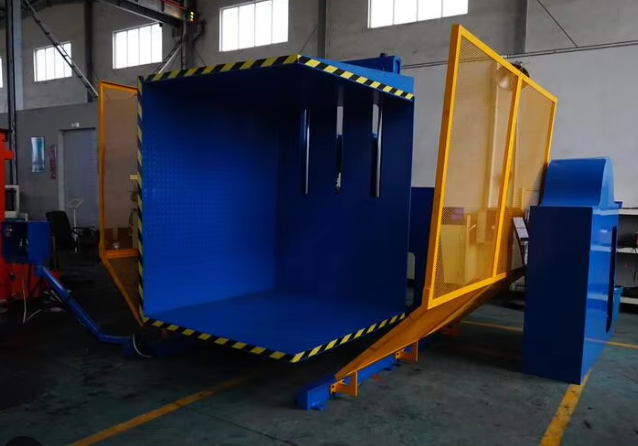
Deeper Dive: A Checklist for Your Investment
Making a significant capital investment requires due diligence. I've always believed in this, whether I was upgrading a single machine or planning a new production line. For a machine like a pallet changer, the analysis can be broken down into clear, manageable steps. Let's walk through them.
Analyzing Your Core Requirements
Before you look at a single brochure, answer these questions about your own operation:
- Load Characteristics: What is the maximum weight of a fully loaded pallet? What are the dimensions (Length x Width x Height)? Is the load stable (uniform boxes) or unstable (mixed items, bags)? This will determine the required capacity and whether you need an inverter or an exchanger.
- Throughput Needs: How many pallets do you need to change per hour or per shift? Be realistic. This will dictate whether you need a semi-automatic machine or a fully automated, inline system. A goal of increasing uptime to 95%, as someone like Javier would have, requires a machine that can keep pace without being a bottleneck.
- Pallet Types: What types and sizes of pallets are you currently using and what will you be switching to? (e.g., GMA, CHEP, plastic, half-pallets). The machine must be able to accommodate all of them.
- Facility Constraints: How much floor space do you have? What is the ceiling height? Do you need a pit-mounted or floor-level machine? Where will it fit into your existing product flow?
The Selection Checklist
Use this table as a guide when evaluating different models and suppliers. This structured approach helps ensure you don't overlook a critical detail.
| Criteria | Question to Ask Yourself / The Supplier | Why It Matters for PPE Operations |
|---|---|---|
| Load Capacity & Size | Does the machine's maximum capacity exceed our heaviest pallet by at least 20%? | Provides a safety margin and ensures long-term reliability without straining components. |
| Clamping System | Is the clamping pressure adjustable? Can it handle our delicate boxes without crushing them? | Essential for protecting product integrity. You can't sell crushed boxes of masks. |
| Material & Finish | Is a stainless steel or powder-coated steel model available? Is it designed for wash-down? | Critical for hygiene. Prevents rust and allows for proper sanitation required in PPE handling. |
| Automation Level | Do we need a standalone machine or a fully integrated, inline system with conveyors? | Depends on throughput. Inline systems reduce forklift traffic and manual intervention, aligning with goals to lower operational costs. |
| Footprint & Layout | Will this machine fit our designated space? Does it allow for efficient forklift access? | Poor placement can create new bottlenecks, defeating the purpose of the investment. |
| Cycle Time | What is the machine's guaranteed cycle time? Can it meet our peak demand? | Directly impacts your facility's overall throughput and ability to meet shipping deadlines. |
I remember a client in the food industry—which has similar hygiene concerns to PPE—who bought a standard pallet inverter based on price alone. It was made of painted mild steel. Within a year, their aggressive wash-down procedures caused rust to form, creating a contamination risk. They had to replace it. Doing the detailed analysis upfront saves you from costly mistakes like that.
What are the key safety and efficiency features to look for?
When you invest in new machinery, you have two primary, non-negotiable goals: it must be safe for your people, and it must make your operation more efficient. A machine that fails on either of these fronts is a bad investment. The problem is that many spec sheets are filled with jargon, making it hard to distinguish between essential features and nice-to-have extras. You might be tempted by a lower price, only to discover later that the machine lacks critical safety interlocks or that its cycle time is much slower in practice than on paper. This can lead to workplace accidents, a direct hit to your company's reputation and finances, or an efficiency gain that never actually materializes.
The solution is to enter the buying process with a clear understanding of what specific features deliver real-world safety and efficiency. You need to look beyond the top-line specifications and ask pointed questions about how the machine is built and how it operates. A robust machine is one that protects its operator as much as it protects the product it handles. An efficient machine is one that integrates smoothly into your workflow and performs reliably, shift after shift.
When buying a pallet changer, prioritize non-negotiable safety features like full-perimeter safety fencing, light curtains at the entry/exit points, and dual-circuit emergency stop buttons. For efficiency, look for a user-friendly PLC control panel, variable clamping pressure to handle different loads, and components designed for durability and low maintenance.
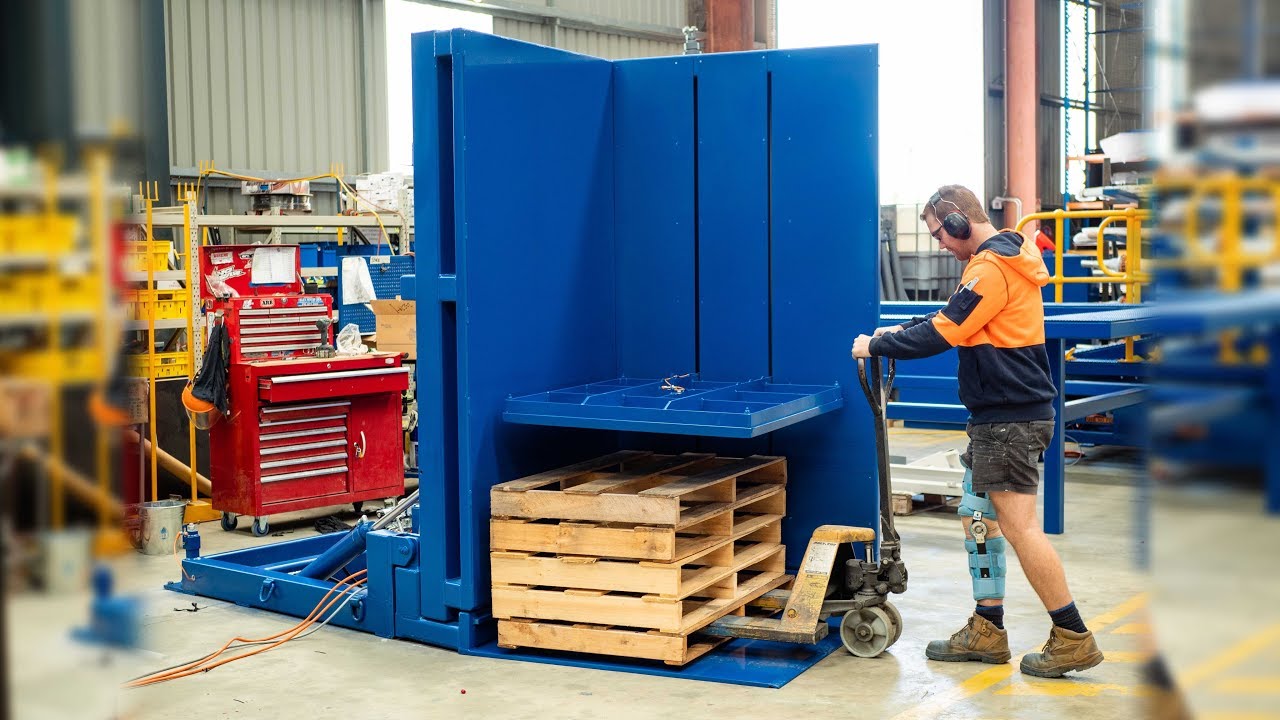
Deeper Dive: Separating Must-Haves from Nice-to-Haves
As an engineer, I love digging into the mechanics of a machine. The small details in design and construction are what separate a world-class piece of equipment from an average one. This is especially true when it comes to safety and efficiency.
Must-Have Safety Integrations
Safety is not optional. A modern pallet changing machine should come standard with a multi-layered safety system. If a supplier tries to sell these as expensive add-ons, it's a red flag.
- Physical Guarding: This is the first line of defense. The machine should be enclosed in robust safety fencing with an access door that is electrically interlocked. If the door is opened, the machine must immediately stop.
- Light Curtains: These create an invisible barrier of infrared light at the pallet entry and exit points. If an operator or a forklift mast breaks the beam while the machine is in a dangerous state, the system halts instantly. This is crucial for preventing accidents in the loading zone.
- Dual-Channel Safety Circuits: All emergency stops and interlocks should run on a redundant, dual-channel circuit. This means if one part of the safety system fails, the backup circuit still ensures a safe shutdown. It's a key requirement for meeting modern safety standards like ISO 13849-1.
- Hydraulic & Pneumatic Safety: Hydraulic systems should include hose-burst valves that prevent the clamps or platform from suddenly dropping in the event of a hydraulic failure.
Features That Drive Real Efficiency
Efficiency isn't just about raw cycle speed. It's about uptime, ease of use, and versatility. These features contribute directly to lowering operational costs and increasing产能利用率 (capacity utilization).
| Feature | Safety Benefit | Efficiency Benefit |
|---|---|---|
| PLC Control with HMI | Allows for programming of safe operating zones and sequences. Provides error diagnostics for quick troubleshooting. | Simplifies operation, reduces training time. Allows for pre-programmed settings for different products, ensuring consistent cycle times. |
| Adjustable Clamping Pressure | Prevents loads from shifting or falling during rotation, which is a major safety hazard. | Protects delicate products/packaging from being crushed. Increases versatility to handle a wider range of SKUs with one machine. |
| Heavy-Duty Construction | A robust frame and high-quality components (bearings, motors) are less likely to fail unexpectedly. | Leads to higher uptime and lower maintenance costs. A machine built to last is key to achieving a 95% effective run time goal. |
| Automated Pallet Handling | Can be integrated with powered conveyors and pallet stackers/destackers to reduce forklift interaction. | Creates a fully automated, "lights-out" process, freeing up labor and maximizing throughput for high-volume operations. |
Investing in these features is part of the rigorous feasibility analysis that any forward-thinking leader undertakes. The initial cost might be slightly higher, but the return on investment through improved safety, reduced downtime, and higher throughput is undeniable.
My take: Beyond the machine, it's about the partnership.
You can do all the technical research in the world. You can create the perfect checklist, analyze every feature, and negotiate a good price. But once that machine arrives at your facility, the real journey begins. The problem I've seen too many times is that the relationship with the supplier ends the moment the final payment is made. When a technical issue arises during installation, when your team needs training, or when you need a spare part five years from now, a "vendor" is often nowhere to be found. This leaves you with a very expensive piece of equipment that isn't performing, and you are left alone to solve the problem. It turns a strategic asset into a strategic liability.
From my own journey—from an engineer on the factory floor to building my own company, SHJLPACK—I've learned that the most successful projects are built on strong relationships. The solution is to actively seek a strategic partner, not just a supplier. A partner has a vested interest in your success. They understand that their reputation is tied to the performance of their equipment in your plant. They provide support throughout the entire lifecycle of the machine, from the initial design conversations to helping you plan for future upgrades.
The best pallet changing solution is not just the machine itself; it is the combination of the right equipment and a long-term partnership with the manufacturer. A true partner provides comprehensive support, including installation, training, maintenance, and strategic advice to ensure you achieve the highest possible return on your investment.
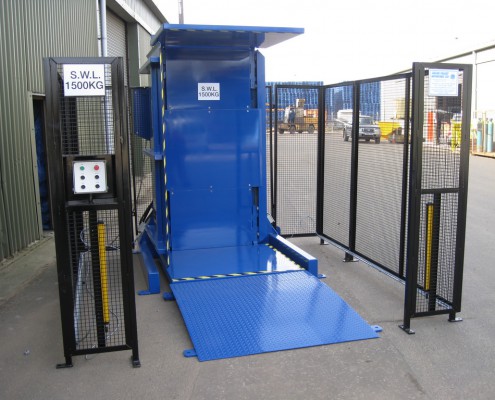
Deeper Dive: The Tangible Value of a Strategic Partner
I've worked with leaders like Javier Morales, who run massive operations and understand that equipment is just one part of a larger ecosystem. They are looking for ways to reduce costs, push for digital transformation, and meet tough environmental standards. A simple equipment vendor can't help with that. A partner can.
What a True Partnership Looks Like
When I started my factory, I was grateful for the mentors and partners who helped me navigate challenges. It’s why I founded SHJLPACK on the principle of sharing knowledge and being a true partner. Here is what that looks like in practice compared to a typical vendor relationship.
| Aspect | Typical Vendor Approach | Strategic Partner Approach |
|---|---|---|
| Consultation | Sells you a standard machine from a catalog. | Analyzes your entire workflow to recommend or customize a solution that truly fits. Discusses long-term goals. |
| Installation & Commissioning | Ships the machine with a manual. Installation support is an extra, often costly, service. | Provides on-site engineers to manage installation, ensure proper integration, and run performance tests until you are satisfied. |
| Training | Offers a basic operational overview. | Conducts in-depth training for both operators and your maintenance team, ensuring self-sufficiency and safety. |
| Maintenance & Support | Sells you spare parts from a list. Technical support is a helpline with long wait times. | Offers a preventive maintenance plan. Provides direct access to engineers for troubleshooting. Uses IoT sensors for predictive maintenance alerts. |
| Future Growth | The relationship ends after the sale. | Stays in contact to discuss future needs. Provides advice on integrating with MES, upgrading for higher throughput, or improving energy efficiency. |
The ROI of Full-Lifecycle Support
For a CEO focused on the bottom line, every one of these partnership aspects has a tangible financial benefit.
- Digital Transformation: A partner can help you integrate your new pallet changer with your MES (Manufacturing Execution System). They can equip it with IoT sensors to gather data on cycle times, uptime, and potential faults. This data is the foundation for achieving full production visualization and moving towards predictive maintenance, a key goal for any modern factory.
- Reducing Operating Costs: A partner helps you lower costs beyond the initial purchase. Proper training reduces operator error and damage. Preventive maintenance plans prevent costly, unexpected breakdowns. Advice on energy-efficient motors and hydraulic systems can contribute to that 10% reduction in unit energy consumption.
- Meeting Compliance: Whether it's evolving safety standards or stricter environmental regulations, a partner keeps you informed. They can help you with the documentation and machine modifications needed to stay compliant, avoiding fines and shutdowns.
This is the "Total Solution" philosophy we live by at SHJLPACK. I achieved my own success because of the chances this industry gave me, and now my focus is on giving back by helping others build more efficient, safer, and more profitable operations through true partnership.
Conclusion
Choosing the right pallet changer and partner boosts safety, efficiency, and hygiene. It’s a strategic investment in your operational excellence and a foundation for your company's future growth.




